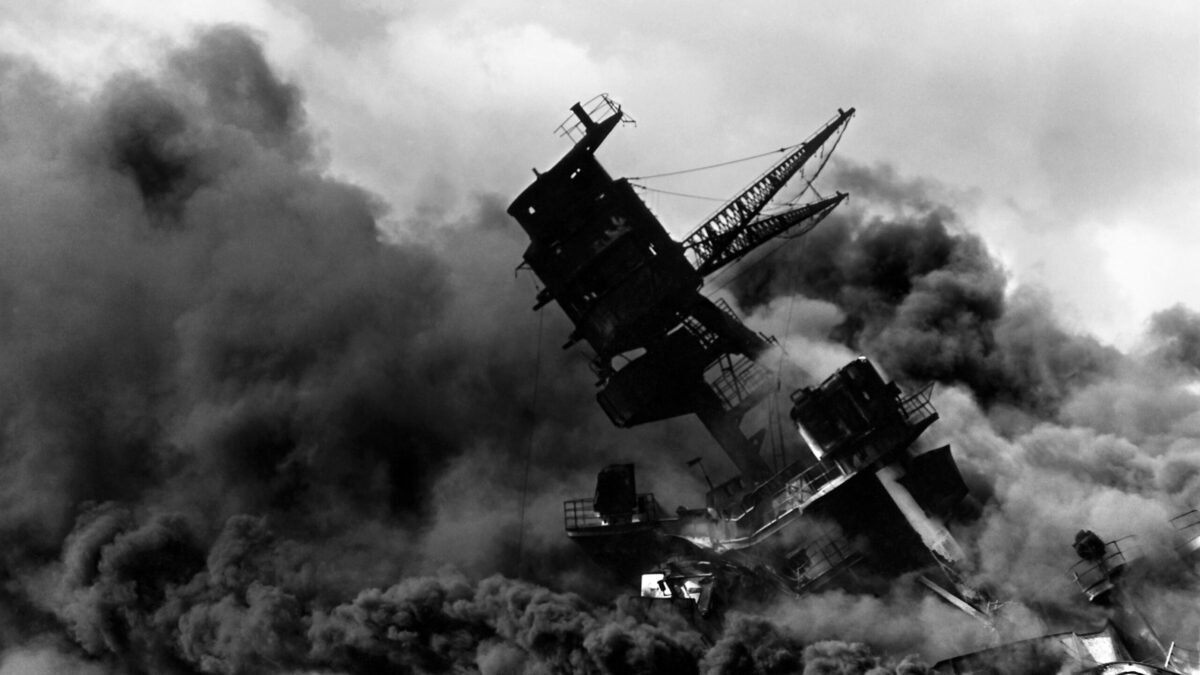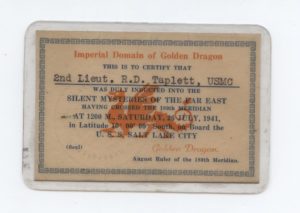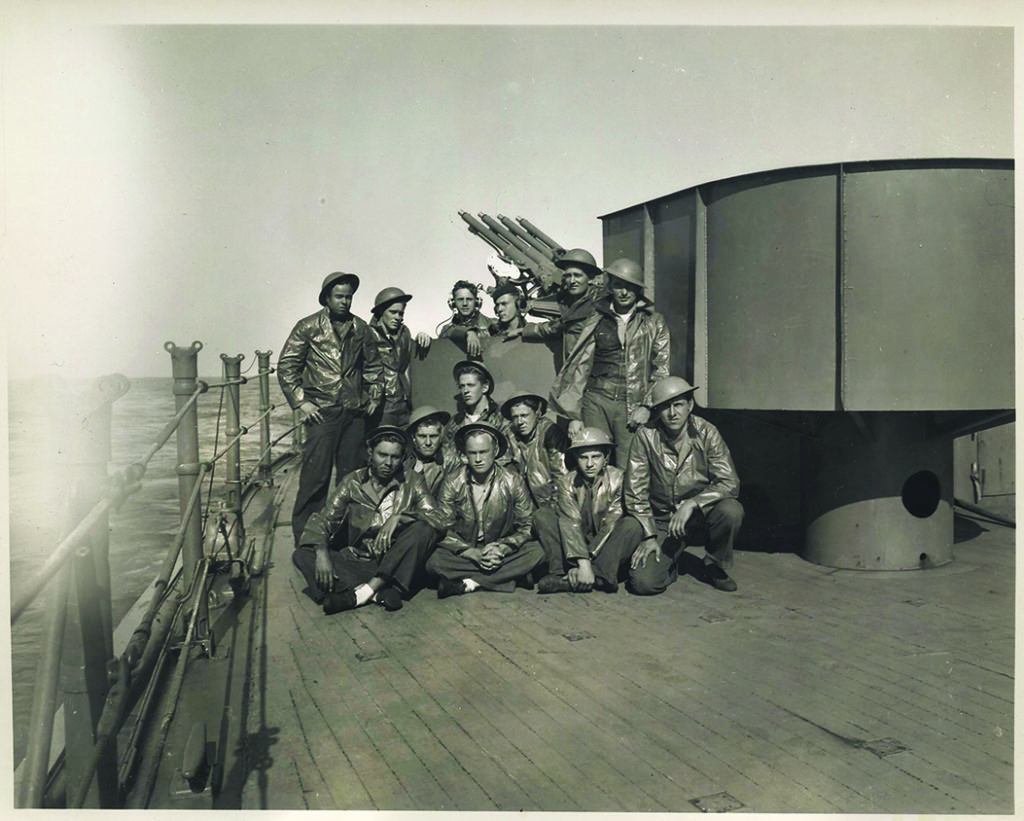Fellow U.S. Marines and military historians know Colonel Robert D. Taplett best for his valor during the Korean War. On September 15, 1950, Taplett, commanding the 3rd Battalion of the 5th Marine Regiment, led the initial landing of an amphibious assault at Inchon that resulted in victory for United Nations forces. Later that year, at the Chosin Reservoir, Taplett and the 3/5 Marines, often struggling against temperatures of -40o, fought nearly constantly for three weeks to keep open a road to the sea that 18,000 American personnel needed to execute a fighting withdrawal from a pursuing Chinese army of 120,000.
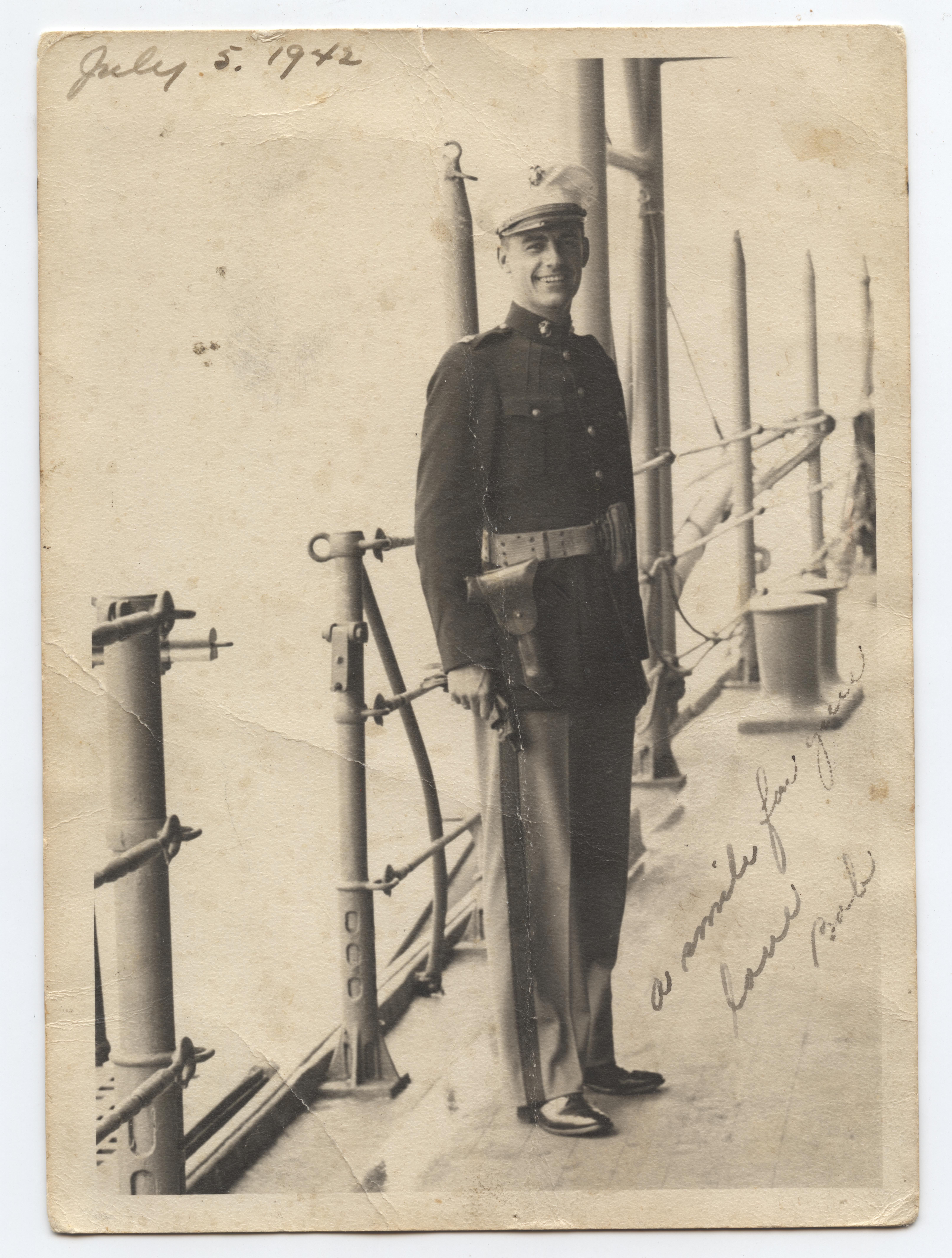
Taplett’s exploits in Korea came to overshadow his World War II service. As a neophyte gunnery officer, he sailed out of Pearl Harbor in late November 1941 aboard the heavy cruiser USS Salt Lake City in a task force accompanying aircraft carrier USS Enterprise, which was delivering warplanes to Wake Island; by happenstance the task force was not at Pearl on December 7, 1941. A few months later, Taplett and his Marine gunners, aboard Salt Lake City, sailed in another task force that accomplished the Doolittle Raid against Tokyo, Japan.
Born in 1918 in Tyndall, South Dakota, population 1,600, Robert Taplett attended the University of South Dakota, where he lettered in three sports. His football teammates included future fellow Marines John Ptak, Joe Trompeter, and Joe Foss, all of whom earned medals for valor during World War II. Upon graduating in 1940, Taplett resigned his ROTC commission and joined the Marines. He trained at the Basic School at the Philadelphia Navy Yard, later relocated to Quantico, Virginia.
In June 1941, the Navy assigned 2nd Lieutenant Taplett to Salt Lake City, the navy’s oldest commissioned vessel, nicknamed, invoking the Japanese for “ship,” both “Swayback Maru” and “Salty Maru.” Taplett commanded the cruiser’s Marine detachment and served as a gunnery officer. Captained by Commander Ellis Zacharias, Salt Lake City, with the rest of the U.S. Navy Pacific Fleet, had taken up station in 1940 at Pearl Harbor, on the Hawaiian island of Oahu. Between June 1941, when he debarked west from California aboard seaplane tender USS Curtiss, and May 1942, when he was seeing combat in the Pacific, Robert Taplett kept a diary. His impressions of going to war appear here in print for the first time, edited for brevity and clarity.
June 15, 1941—Sailed from San Diego on USS Curtiss, about 90 passenger officers aboard. In the afternoon, we pulled into Long Beach. After a one-hour stop, we shoved off. In a few hours, the mainland faded. How long before I see it again?
June 16–21, 1941—At sea. An excellent trip and profitable from the poker standpoint.
June 22, 1941—Sailed into Pearl Harbor 9 a.m. The first view of the islands was impressive. There seems to be a constant rainbow.
June 23, 1941—Officers disembarked to their ships, except Cornnell and myself. We were sent to the Chester, then the San Francisco. Took the pistol team ashore to fire.
June 25, 1941—Transferred to the Indianapolis; Walter Cornnell also. Wonder where Salt Lake City is? And still no mail!
June 26, 1941—Salt Lake City is in. Reported on board to relieve Lieutenant Carl Larsen—a boy from South Dakota. Really a treat to talk to someone from your own state. He’s to leave Saturday on the [passenger liner] Matsonia—lucky stiff, going back to be married.
Monday, July 7, 1941—Diarrhea. Nearly everyone feeling awful.
July 9-15, 1941—Took sailors to the range for firing. Stood 2 watches. Rumors circulated like mad that shore liberties had been canceled—we were grouping to go someplace.
On Wednesday, July 16, 1941, Salt Lake City and Northampton departed Pearl Harbor for a 4,700-mile “familiarization cruise” to Brisbane, Australia. A Dutch-flagged freighter ferrying volunteer American aviators to fly in China for General Claire Chennault and the Flying Tigers joined the cruisers. En route there were frequent episodes of General Quarters, the summons to battle stations, and Condition III, a state of heightened alert. Taplett served as an advocate in courts martial and oversaw gunnery practice. Loading an antiaircraft gun, a Marine lost a fingertip. On Tuesday, August 5, 1941, the ships reached the mouth of the Brisbane River. Led by a pilot boat nine miles upstream through a heavily mined channel, the cruisers anchored at Brisbane for a five-day visit. Australians were happy to have American warships at hand; some asked Marines for autographs. Back at sea, Royal Australian Air Force pilots staged mock attacks on the ships. In such exercises, Taplett’s anti-aircraft gunners strove to qualify for a rating of “E” for expertise. At New Guinea and New Britain, he and shipmates saw their first volcanoes before turning home to Honolulu. Arriving at Pearl Harbor on August 25, Taplett found 50 letters, including several from the young woman he had been seeing before enlisting. Her name was June; he called her “Dune.” He replied to Dune and wrote to his younger brother Howard, known as “Dud,” who would follow him into the Marines and be wounded on Iwo Jima, and to their sisters Margie and Evelyn. Older brother John was serving in the Navy. Taplett was assigned to coach Salt Lake City’s basketball team and to serve as assistant baseball officer. An entry about a bash for fellow Marines departing Hawaii for the mainland ends, “Don’t quite remember getting to bed.”
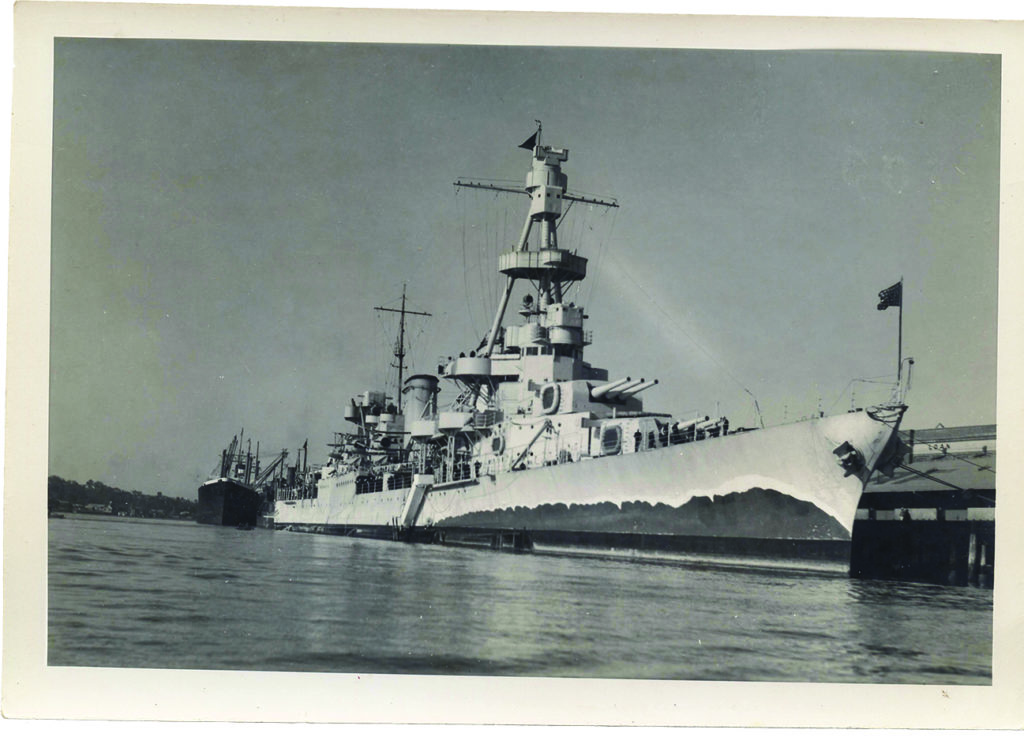
Monday, September 1, 1941—Spent an hour or so at the Club. Thrilling day—just a lonely guy. Maybe I ought to get a date. Slept & sunbathed. Saw a lousy movie. Read awhile, wrote to Dud. Wonder if Dune was teaching today.
Tuesday, September 2, 1941—Rumors that we will be headed for the coast. Hope so! Checked rifle & pistol qualifiers. Saw a wonderful movie, That Hamilton Woman. Was tempted to go to the Club but decided I’d better write letters and go to bed. The moon has been so pretty the last couple of nights! Would be perfect if we were sharing them, Dune.
Wednesday, September 3, 1941—Checked AA guns. Golfed at Oahu Country Club. Shot 103. What a view of Honolulu. Dinner alone, back in time to see The Belle of New Orleans. Captain & I went to the Club for drinks.
Thursday, September 4, 1941—Left Pearl Harbor to cruise and fire short range battery practice & AA. Quite a bit of the fleet is with us, including the Enterprise. Planes in the air almost constantly. You ought to see dive bomb runs. Practiced night submarine defense. Course took us through Molokai, Lanai, Maui, etc. What I couldn’t do with one of these Hawaiian moons and Dune.
Friday September 5, 1941—Planes were on 30-second notice. I sure like to watch them leave the catapult. The flying bug is getting me. This afternoon, spotting drill. In the evening, a mock naval engagement against Arizona, Enterprise, & destroyers. The moon was almost as bright as daylight.
Saturday, September 6, 1941—Nothing like a shore duty Saturday. Machine guns fired, AA, battle practice. Check-sighted the aft machine guns. Only one hit. Very busy with drill, bringing up and checking over ammo for firing Monday. This evening we neared the harbor to taxi in a plane which my roomie had banged up landing today. Honolulu so pretty at dusk. Two more courts today. One is going to be terrible. Oh, well. I’ve got tomorrow to work on them.
Sunday, September 7, 1941—5” gun loading drill. In the afternoon and evening worked on courts. Went to bed early. Pooped.
Monday, September 8, 1941—Fired short range battle practice. Looks like I’ll lose at least one keg of beer to my Marine gun crews as I’m sure they will get an E. Everything breakable removed but even so we shattered things. How these big babies shake the ship. Tonight: searchlight drill! Wrote to Dune and am going to work on the courts I have tomorrow.
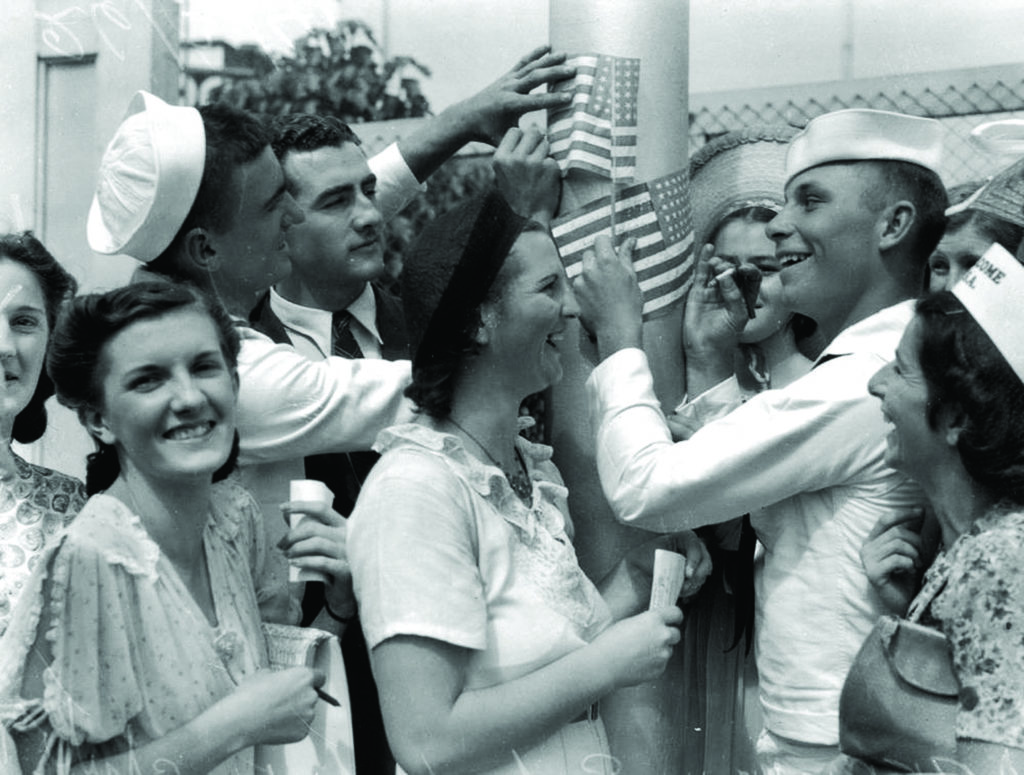
September 9-11, 1941—Tuesday: Torpedo defense. At 2:30 our “not guilty” case met ’til 5 p.m., then adjourned. After dinner was settling down to work when General Quarters went. After it was over I hit the hay. Awoke early to the tune of flight quarters. Breakfast, drill call, and morning was over. Sounded torpedo defense in the afternoon & rehearsal runs. AA and battle practice. Secured at 4. Court ’til after 5, when we adjourned. It looks like we won’t get a conviction. After General Quarters and about an hour of searchlight drill went back to work on the case. Spent most of the night with Captain Cobb who really knows his law. I have two more courts. A-scurrying I went to dig up the accused and get matters straight. Flight Quarters for homeward-bound pilots at 12. At 12:20, Flight Quarters again—man the crash boats, rig for refueling, sound torpedo defense, almost simultaneously. Finally got to fire some guns. Ammo was 88% duds. By the time we retrieved firing sleeves, it was too dark to retrieve planes, so they had to return to Pearl. General Quarters. Oh, hell—I could have put in for shore duty.
Salt Lake City beat Chester at basketball 53-34. Coach Taplett joined the cruiser’s captain for a Honolulu binge that ended just before the ship sailed for Long Beach, California, with its basketball coach down with measles.
Friday October 10, 1941—Back to work, woozy. Loafed & supervised.
Saturday October 11, 1941—Full power run. How the ol’ bus did shake! Holiday routine in the afternoon. Able to pick up radio from the coast—listened to football games. Dance bands & good music, this is the way it should be! Still have the sore throat. Wish I were going on leave! Hope Dune comes out, but I’m doubtful—very.
Sunday, October 12, 1941—Supposed to anchor at midnight. Gives you a queer feeling to stand on the forecastle & know that in the dull glow in the sky lies good ol’ Los Angeles & home.
Undated—Leave canceled. Left Long Beach October 31, arrived Pearl November 7. Left Pearl November 9, back November 18 for yard work.
Salt Lake City and other warships were ordered to form a task force protecting aircraft carrier USS Enterprise, about to depart Pearl Harbor for an undisclosed location. Another carrier, USS Lexington, had left the anchorage earlier in similar circumstances.
Friday, November 28, 1941—Under way very early. Indications point to a journey to the Philippine Islands. We have orders to shoot on sight. I thought we were in a state of readiness before but nothing like this! Bombs for the planes, ready boxes full, guns ready to go. Everyone has that pre-game look.
Saturday, November 29, 1941—Condition III and General Quarters. Sleep is where you can find it! No dope as to our destination.
Sunday, November 30, 1941—We’ll be lucky to mail Xmas cards. Glad Eve is doing my shopping, but I wonder what Dune will think.
Thursday, December 4, 1941—Mother’s birthday. Looks as if we are headed for Pearl. Evidently, we got near Wake. I believe we left planes from Enterprise there. We didn’t see the island—everything is shrouded in secrecy. We are still in Condition III and go to General Quarters at sunrise and sunset.
Friday, December 5, 1941—Blustery. General Quarters becoming tiresome. Sometimes Condition III takes on aspects of farce.
Friday, December 5, 1941—Crossed the date line, hence 2 Fridays. Weather still bad.
Saturday, December 6, 1941—Even rougher. Waves wash over the forecastle. Refueling tin cans [destroyers].
The Lexington task force, later revealed to have been delivering planes to Midway Island, was still a week out of port when the Enterprise task force arrived outside Pearl Harbor late on December 6. Because the harbor’s anti-submarine nets were obstructing access, the Enterprise task force sortied south into open seas.
Sunday, December 7, 1941—At 9:30, I was on watch. Message came through: “AIR RAID ON OAHU—THIS IS NO DRILL.” The rest of the day was rumor & reports. Tense and terrible, waiting waiting waiting. About 4 another alarm. Planes from the Enterprise close overhead, carrying torpedoes & bombs. A destroyer got a submarine off our port quarter. Task Force I joined us. Everyone clamoring for news, but all we could get was meager radio reports. Seems like a year transpired in those hours. Low on fuel.
December 8, 1941—Fitful sleep. Destroyers got another sub. Proceeded to Pearl, cautiously. The first thing we saw was smoke from Arizona. One of our planes, shot down by our forces. Nevada, blown to hell. A sickening mess. Hickam Field, Ford Island, hangars in shreds, planes in smithereens. Utah bottom up, also Oklahoma, West Virginia. Tennessee was a wreck. Tenders, tankers—Lord, could this be possible! The Japs had Pearl Harbor memorized—even the berthing plan. Our Pacific Fleet consists of 1 battleship and a half dozen or so cruisers. We are sitting wide open next to a tanker. Hope we move out tonight. Jap subs got into the harbor to sink battleships & a light cruiser. I hope & pray my classmates on board these vessels are safe. God give us courage and will to right this wrong.

Tuesday, December 9, 1941—The night was tense. Watch was a nightmare. All around reminders of destruction. Arizona still casting a sinister glow. Off our starboard lay Utah, bottom up. We took in provisions & stores. 100+ men reported, survivors from Oklahoma, West Virginia, etc. We went to General Quarters on a report that the Japs were attempting to land at Fort Weaver. Seemed like it took a year to refuel. Under way 4:30 a.m. I’ll never forget that grim trip down the channel past torn ships and buildings. Most of us hadn’t slept since Saturday night. By going to Condition III, some of us got about 6 hours of sleep. Jap planes must be operating from carriers. All we know is that we are on the defensive. Hell of a time for the country to say, “We are behind you to the finish.” Why can’t we see ahead? Admiral Yarnell has taken over.
Wednesday, December 10, 1941—What a day for a birthday! Torpedo defense. Fired our first shots of the war—3. Periscope appeared at about 2:30 and again at 5:45. We could feel depth charges. Wake, Guam still in our hands. We are learning fast, I hope! Our planes bombed 3 Jap subs, which crash-dived. I’m 23.
Thursday, December 11, 1941—From General Quarters in the morning ’til General Quarters at night we were reporting subs. Sighted periscopes and let go with the 5”. Destroyers laid cans [depth charges, also known as ash cans]. Believe we got 3-4. One was seen to come up in two hulks. Enterprise planes claimed to have got 1 and damaged 4. The Detroit captured one—60 ft long, 5 ft beam, 2 men, 2 torpedoes, cruising radius 60-to-120 miles. They must have hundreds. Averaging about 18 hours a day on the guns.
Friday, December 12, 1941—Trouble with ammo on the forward battery—careless handling ruptured a case. Our planes went up for the first time since the war started. Sub scares. Destroyers dropped ash-cans.
Saturday, December 13, 1941—Mid-watch last night and the 1st day this afternoon. Didn’t get much sleep. Tokyo press claims Japan bombed Pearl Harbor 6 times last Monday. Must have been some bombing, as we were refueling there that day. We again launched planes for patrol.
Sunday, December 14, 1941—Refueled & re-provisioned 3 destroyers. The sea is the roughest we’ve had. Refueling is tricky. A can [destroyer] bumped our starboard side. Darn chilly. We, the richest nation in the world, capable of anything, have ships whose AA protection consists of antiquated 5” guns. We give men rifles & machine guns & automatics to shoot at planes. I wonder what the people of the nation would say & think if they knew.
Monday, December 15, 1941—Rough seas. Weather terrible and without a moon it is worse. We are about 600 miles north of Oahu.
Tuesday, December 16, 1941—We were to go into Pearl but were delayed, evidently by a task force coming out that included Lexington. On our way in we saw B17Es, the newest Flying Fortresses, and the other side of Ford Island. California, Oklahoma, West Virginia, & Arizona. About 5 p.m. we tied up to a buoy. Enterprise followed us in, then Chester & Northampton and cans. Louisville tied up next to us. They had convoyed ships from the mainland. Everyone expected liberty but we are in Condition III—not to be caught flat-footed again. Martial law declared and prohibition is in effect; not much to go ashore for. Wrote home and to Mil. Hope we get mail tomorrow.
Wednesday, December 17, 1941—Another Jap sub got in. It was sunk. I wonder how many more are waiting. The 3rd section and married men got an 8-hour liberty. All came back with weird tales. Spent the morning censoring mail. Talk about filthy letters. Slept, then stood the first day watch. Got my birthday gift from home. Wonder how long it will be before the army gets the lead out of their pants. The Marines are proving to be real devil dogs at Wake Island. They were asked what they needed and they came back with “Send us more Japs.” Took on provisions, better than 60 tons—twice as much as usual. Replenished ammo—400 rounds to replace drill & target stuff. Looks like Texas, Pennsylvania, and Maryland will soon be back in shape.
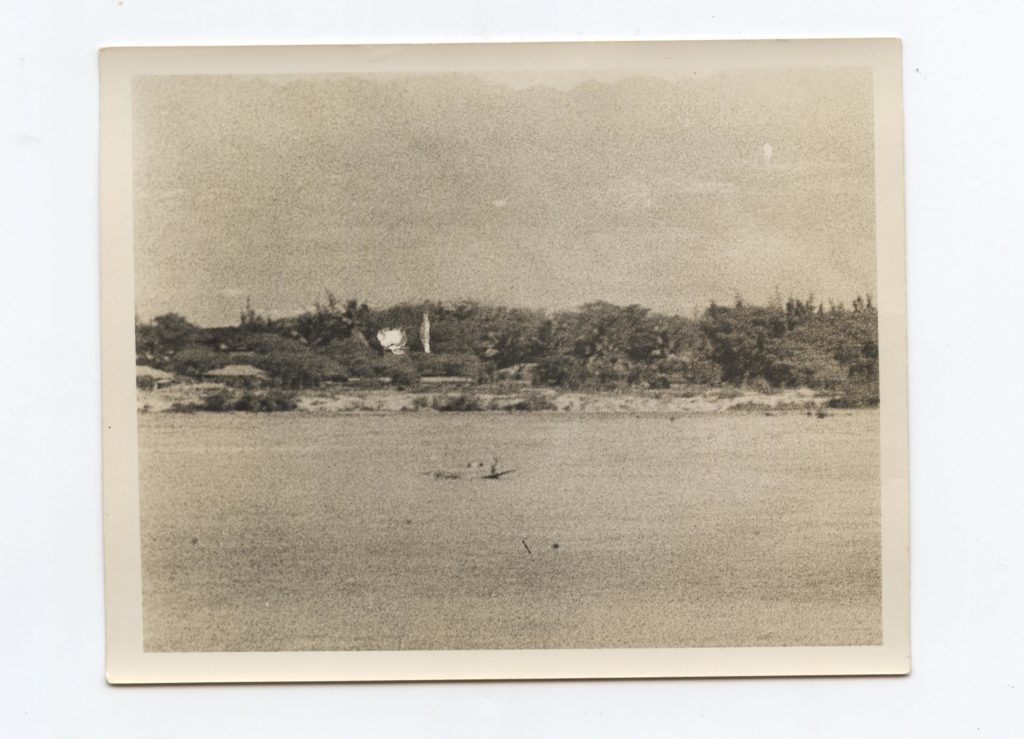
Thursday, December 18, 1941—4-8 a.m. watch and for the first time in 21 days went ashore on liberty. Stopped at the Club to pay my bill. Everything serious & businesslike. No liquor & no drinking. Saw the captured Jap sub. It seems unreal that 2 men could live in it. Talked to Swede Larsen, learned that 2 classmates were killed. Cy, on Arizona, caught a burst of machine gun bullets at the top of a ladder. Gavin, on Oklahoma, is missing. Poor fellows didn’t have a chance. Everywhere soldiers, sailors & Marines with guns. The yard juts with gun emplacements. Windows painted black & signs reading “Business as usual.” Went to a movie, shopped, had dinner, came back 2 hours before liberty was up. Had a terrific headache. Took 3 aspirin & went to bed.
Friday, December 19, 1941—Under way very unexpectedly. We’re headed for the South Seas and trouble. Condition III in day time and General Quarters at sunrise & sunset, meaning sleep when you can.
Saturday, December 20, 1941—Enterprise planes all in the air. Saw a beautiful job of night flying. A plane was lost for a couple hours. When we saw him make it safe, fellows on deck cheered. Most everyone is anxiously expecting contact with the enemy.
Sunday, December 21, 1941—Sunny & warm. Tried to write Dune but can’t. Tried to sleep, gave up, went into the bunk room to play records. After lunch loading drill. Getting ready to go on watch.
Wednesday, December 24, 1941—No Xmas feeling. Stood watches most of the day. Spent Xmas Eve standing watch at the guns in a downpour. Home seems so far away. Sometimes this all seems like a dream.
Thursday, December 25, 1941—Felt like it would snow. We are north and west of Midway, crossing & recrossing the date line. We’ve had Xmas 5-6 times. Watch in the rain 9:30, off at 12:45. Had lunch, played pinochle. Slept about an hour, watch 4-6 p.m. Xmas dinner. Captain Zacharias held everyone’s attention telling of his prediction of the disaster at Pearl Harbor. Went to bed at 9:45, up at 11:30 & on watch till 8 a.m. Some Xmas.
Friday, December 26, 1941—Off watch 8 a.m. Breakfast, pinochle, aired bedding, laundry inspection. 27th day at sea in 29 days. Rolling, rocking December, eh?
Sunday, December 28, 1941—4th week of the war. Seems like it’s been a year. Japs still on the offensive. Felt good in the sun. Headed for Pearl. Supposed to be in on the 31 of December. I’ll be really looking for mail.
December 30-31, 1941—Arrived Pearl for yard work. Tennessee & Maryland gone—to the states, I presume.
In early January 1942, Salt Lake City underwent an overhaul that included fresh paint and installation of radar, 40mm Oerlikon AA gun mounts, and banks of 1.1” anti-aircraft machine guns, commonly called pom-poms. Taplett and his gunners had to retrain. Officers were ordered to ship home civilian clothes and dress uniforms. Pearl Harbor remained on edge. False alarms abounded. At Admiral William Halsey’s order, Salt Lake City sailed as part of a task force, refueling at sea from a tanker. Also aboard was Life Magazine photographer Bob Landry. “I’ve seen enough Hawaii,” Taplett wrote. “Nothing to do & too little time in which to do it.” He speculated on rumored plans for an attack on a Japanese submarine base. “They won’t disclose location, course, nothing. We probably won’t hear ’til the last minute and then have to prepare hastily,” he wrote. “I am finding it harder each day to keep up interest in this war.” Salt Lake City figured in a March of Time newsreel about Wake Island, to which Enterprise had delivered a dozen pilots and aircraft just before the Japanese attack there. “Our task force brought those 12 planes. Odd to think now that we were taking 12 men to sure death,” Taplett wrote. “December 10-20 we were in the vicinity, prepared to evacuate, but ran. Maybe there were good reasons but dammit why wasn’t the Navy prepared? The Navy says they can’t risk us as we ARE the Pacific Fleet.”
Gunner Clarence Frederick Tyler, killed in an accident in an 8” gun turret, was buried at sea. A torpedo plane missed a landing on Enterprise and went into the ocean. Another plane crashed near the cruiser. One man drowned. The task force reached what appeared to be Samoa.
Tuesday, January 20, 1942—Beautiful sunrise. Even Landry was up to take pictures. Sunsets are honeys also. 2 of our aircraft flew patrol. Enterprise seemed to have more planes in the air. Breaking in reserve AA crews from the turrets. My General Quarters station moved to the after pom-poms, but I still stand Condition Watches on the 5” guns. Brad failed to return. He was in a rainstorm at 11,000 feet. His gas gave out around 8:15 p.m. Such a fine guy.
Wednesday, January 21, 1942—A plane from Enterprise spotted Brad and we picked him up, plane intact. I understand we are to assure disembarkation of 8,000 Marines from the Lurline, Mariposa, & Monterey [passenger liners]. Crawley came back. He was at Samoa. Saratoga torpedoed off Oahu. Flooded 3 boiler rooms but she got back to Pearl.
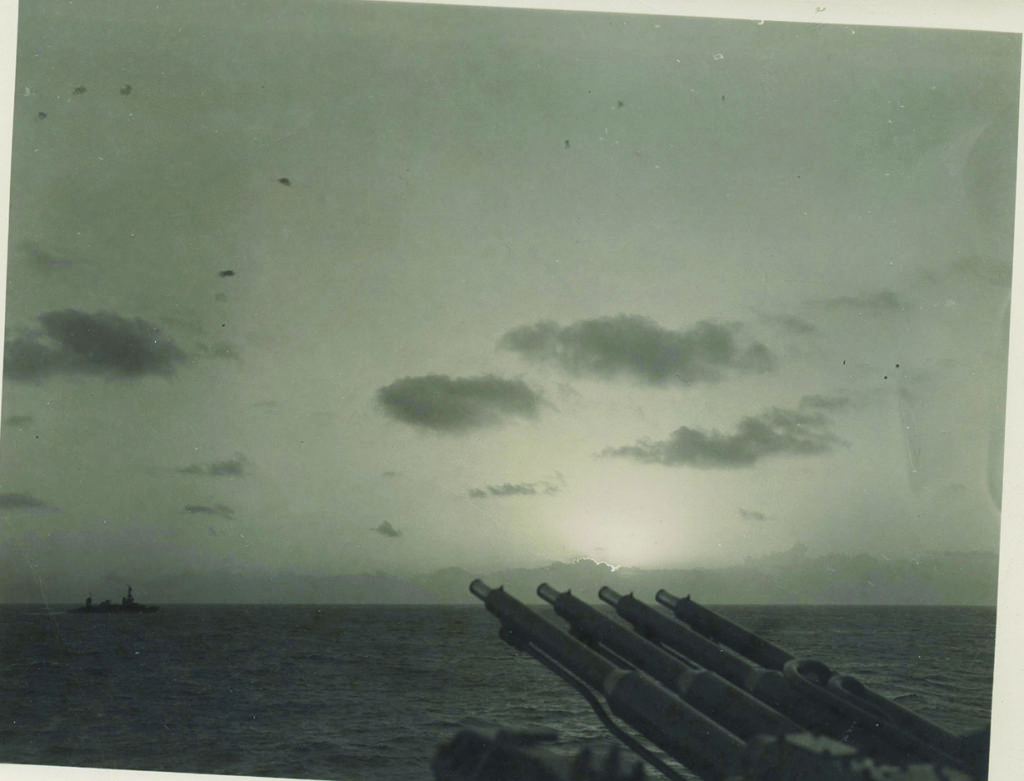
Thursday, January 22, 1942—Still in the Samoan Islands. May be weeks before we get to Pearl. Maybe we’ll hit something on the way. Good source says it will be Jaluit (Marshall Islands), where there’s a Japanese fleet. Learning semaphore, slowly! Condition watches getting more wearisome.
Friday, January 23—Mid-to-8 a.m. watch. Had an alarm & all battle stations were manned completely in 2 mins—some sort of record, as most off watches were in their bunks.
Saturday, January 24—The Captain spoke to us. He said our mission at Samoa is done and we are to attack Japanese forces in another area. Hope we give those slant-eyes a taste of their own medicine! Four destroyers in the Asiatic Fleet made a successful night attack on a Japanese fleet. Sank 1 big ship, blew up another and another had a bad list. One hit sustained by our destroyer—only 4 injured. No letup in hot weather, rainstorms. The report of the inquiry at Pearl Harbor was made public. Someone should fry. Everyone itching for a fight.
Wednesday, January 28, 1942—Stood my first watch in the director in Sky Forward [gunnery control]. The task force commenced fueling. We fueled 2 destroyers, re-
fueled from the Platt. Launched 2 planes. Battle of the Macassar Straits still in its fury. Looks like our forces are doing well. Claim 60+ enemy ships. The damn Limeys still withdrawing in Malaya. Enterprise completed fueling 2 a.m. On our way.
Thursday, January 29, 1942—Crossed date line so it becomes: Friday, January 30, 1942. Planes launched yesterday stayed overnight on Chester & Northampton. We seem to be headed for Jaluit [in the Marshall Islands]. The Captain spoke to the ship. If air bombardment is successful we will do shore bombardment. May be fighting off enemy planes. “Dress rehearsal” this afternoon. Those ol’ pom-poms better do their stuff. God, help us be successful! Started on investigation today of the junior officer laundry racket. It looks bad for somebody.
Saturday, January 30, 1942—Task force split up. Northampton and one destroyer stayed with us. Chester and 4 cans, Enterprise and several cans composed two other groups. Ship cleared for firing. Had the mid-to General Quarters watch, long day.
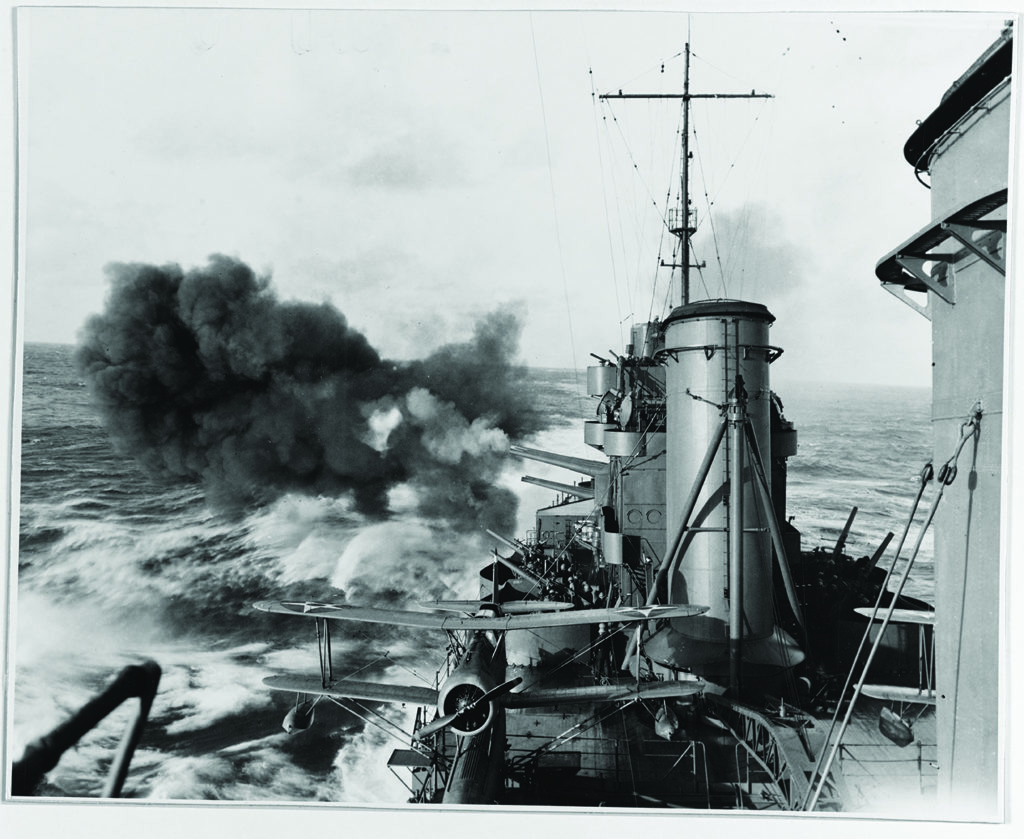
Sunday, January 31, 1942—General Quarters 0545, Flight Quarters 0615. Planes bombed Wotje 0658-0714. Salty Maru is now officially in this war! We opened fire at 0715. Bombardment lasted ’til 0945. Damage was heavy: 6 ships—armed merchantmen, oil tankers—radio towers & communications, docks & warehouses, storage, barracks, airfield, etc. All planes returned at 1115. Lost one plane on recovery—“Hard Luck” Brad. Destroyer picked them up, but plane was lost. At 1325 enemy planes attempted to bomb Enterprise. Several hits close aboard to Enterprise. 4 twin-engine bombers shot down. We accounted for at least one. Around 1530 two bombers, same type, at high altitude. AA kept them high. One burst scored & down came a plane. General Quarters all night, radar contacts, but storm clouds & bad weather allied with us. Most AA personnel spent 36 hours almost uninterrupted at their guns. No casualties, only a ruptured barrel on No. 8 5” gun. First known casualty was an enemy auxiliary vessel sunk by a destroyer to our stern. Admiral Halsey sent a dispatch: “Well done. You have made History in the Marshall Islands, I am proud to have you in my command. God bless you.”
February 5-11, 1942—In port. 5 new officers on board. One is an aviator from North Dakota. Taking on ammunition and provisions. These poor lads get hell worked out of them. Busy as hell. Standing watches & liberty twice. Sent Mom a luncheon set & necklace & bracelet.
Wednesday, February 11—Rumors running wild, talk of heading to the States, etc. Went for a flight with Lon and saw Pearl Harbor from the air, quite a sight. Got down in time for lunch. Censored mail. Wrote home and mailed package to Mom & Mil. We were to get under way tomorrow but again, canceled!
February 15-23, 1942—Under way. Learned where we’re headed. Watches & gunnery drills. Practice firing 1.1’s. Trouble with fire control.
On February 23-24, 1942, the task force attacked Wake Island. Bombers from Enterprise were late arriving. Taplett saw American fighters down a four-engine enemy bomber: “He hit with a big splash & left a beautiful trail of smoke.” Salt Lake City launched and retrieved float planes. “Enterprise beat it & we were left to fend,” Taplett wrote. “A four-engine Jap naval patrol plane began shadowing us, out of range. 4:30 two twin-engine bombers appeared high overhead. We cut loose. Looked like they couldn’t miss. Hard right rudder and the bomb smashed close aboard starboard, abeam of us on the stern. 4 salvos hit the 2nd plane.”
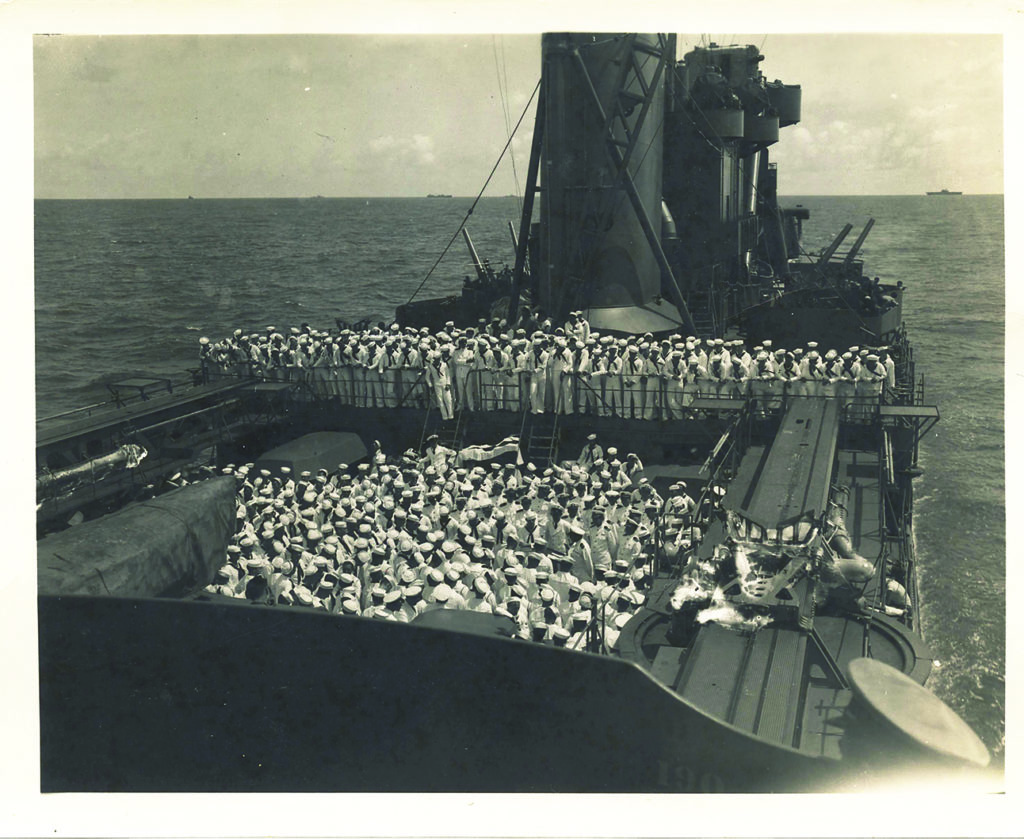
Wednesday, February 25, 1942—Relaxed around noon. Slept, unloaded the 1.1s & sent ammo below. So this is war!
Thursday, February 26, 1942—On our way, supposedly Marcus Island—too near Japan & big air base! Rejoined tanker, caught up with Enterprise. Ran into fog and bad weather. Watches are wet, cold and miserable.
Saturday, February 28, 1942—General Quarters 3:30 p.m.: sub scare. After 20 minutes, we secured. Weather winterish. Captain spoke to the crew and said our return to Pearl would be delayed. Looks like we’ll get closer to Japan proper. May see lots of air action. Still cold, wet & foggy. Feels good, though. Radio Tokyo admitted the raid on Wake but claimed to have sunk one of our cruisers & damaged another. Wonder where. They did come close—too close!
Monday, March 2, 1942—On our way to Marcus. Enterprise planes to raid, we are along to protect. Destroyers departed with the tankers, so now there are just we three.
Tuesday, March 3, 1942—Much clearer. Made out income tax and slept. Loafed 4-6.
Wednesday, March 4, 1942—Japan claims to have shot down 7 planes at Marcus. I saw all return but 1.
Thursday, March 5, 1942—Joined tankers. We are to remain at sea. Something’s up.
Friday, March 6, Friday—Again crossed the meridian—2 Fridays. New pay bill in Congress—sounds good!
March 11–25—In Pearl Harbor. Liberty, etc.
March 16-21, 1942—Machine gun school 20mm.
March 25-28, 1942—At sea. Practice firing AA. Drone torpedo & high-level attacks. 2 drones shot down.
March 28, 1942—Into port. Lexington, Indianapolis, San Francisco, Minneapolis, Louisville came in the 26th. Raised hell at Rabaul. Claim 26 ships & 18+ bombers. Heard Mike Barrett was on the Houston, sunk early in March.
President Franklin Delano Roosevelt and the Joint Chiefs of Staff had decided in secret to retaliate for Pearl Harbor with a surprise attack on Tokyo. For months U.S. Army Air Force bomber pilots led by Lieutenant Colonel James Doolittle had been training in Florida, learning to take off in heavily loaded Mitchell B-25s from runways shortened to simulate an aircraft carrier deck. In April 1942, USS Hornet became the hub of a task force setting forth to even the score with Japan. That task force included Salt Lake City.
Wednesday, April 8, 1942—Under way, same task group as before. Wonder where to. Casey [journalist Robert Casey of the Chicago Daily News] and Commander John Ford [the Hollywood director] aboard. Tested short range guns. Slept. Brought machine gun logs up to date. Still no mail. Course 245o. General Quarters 4:40.
Sunday, April 9, 1942—Splendid night’s sleep for a change. Gunnery drill, stood watch. Brewer gave me a job: qualify 157+ men with the pistol. Bataan surrendered. Rumored English lost 2 cruisers and a carrier in the Bay of Bengal. 8-12 p.m. watch—dull!
Friday, April 10, 1942—Worked on pistol lists. 12–4 watch. Loading drill and instruction. Cooler. Must be easing north. Planes on scouting hop. Sea almost too rough. Took an hour to recover 4 planes. Lon came in fine, the rest had trouble. Got the “mid” coming up, so will hit the hay.
Saturday, April 11, 1942—4-6 watch, 4-8 in the morning. Right cold. Still going northwest! Spring must be well in in South Dakota. Mm!
Sunday, April 12, 1942—Our course still northwest. Looks like even colder weather ahead. Tomorrow we rendezvous with Vincennes, Nashville, Cimarron, and 4 destroyers. The coast of Japan—that’s my dope. Carrier planes fly air patrol constantly. One cracked up landing! Allied air offensive in Southwest.
Monday, April 13, 1942—General Quarters 4:30. Like a winter morning in South Dakota. 8-12 a.m. watch. The other carrier group joined us at 0630. What a surprise—she is loaded down with [scribbled out]. Captain spoke to the ship, said we were attacking “Japanese territories.” Everyone has a smile a mile long. Maybe [scribbled out] will join us. My theory is [scribbled out] will attack without declaring war, simultaneously with our push.
Wednesday, April 15, 1942—Still going west, heading for Tokyo. General Quarters 0500. Wet cold and against the wind. Visibility bad, sea rougher than ever. Rained and sleeted. Everyone is bundled up. It’s luxury to get inside. With two carriers, we have something to work with. It is spring back home. Trees leafing and birds. S’funny how one never notices those things when you have them. Winter in April! Dad’s birthday!
April 16, 1942—General Quarters 4:30. About froze. Shifted to the 4th Section so it means a 2000–2400 watch instead of all night in. Aren’t I the lucky one. Read a book…And Now Goodbye, by James Hilton, very good. American bombers attacked the Philippines. Night watch wasn’t bad. Clear, cold. Felt like there should be crisp snow underfoot. I wonder if trees are leafing in South Dakota. Getting by on very little sleep. Before this journey is over we’ll be getting less.
Thursday, April 17, 1942—So women will now be commissioned in the Navy! Some stuff! General Quarters 0450. Still winterish. Just so it doesn’t freeze! We are fueling from Cimarron. Late this afternoon or tomorrow we’ll head in at good speed and pray we aren’t discovered! Those [“B-25s” scribbled out] better do their stuff. To lunch. Fueled. Weather is lousy but just the kind we need: rainy, foggy, etc.
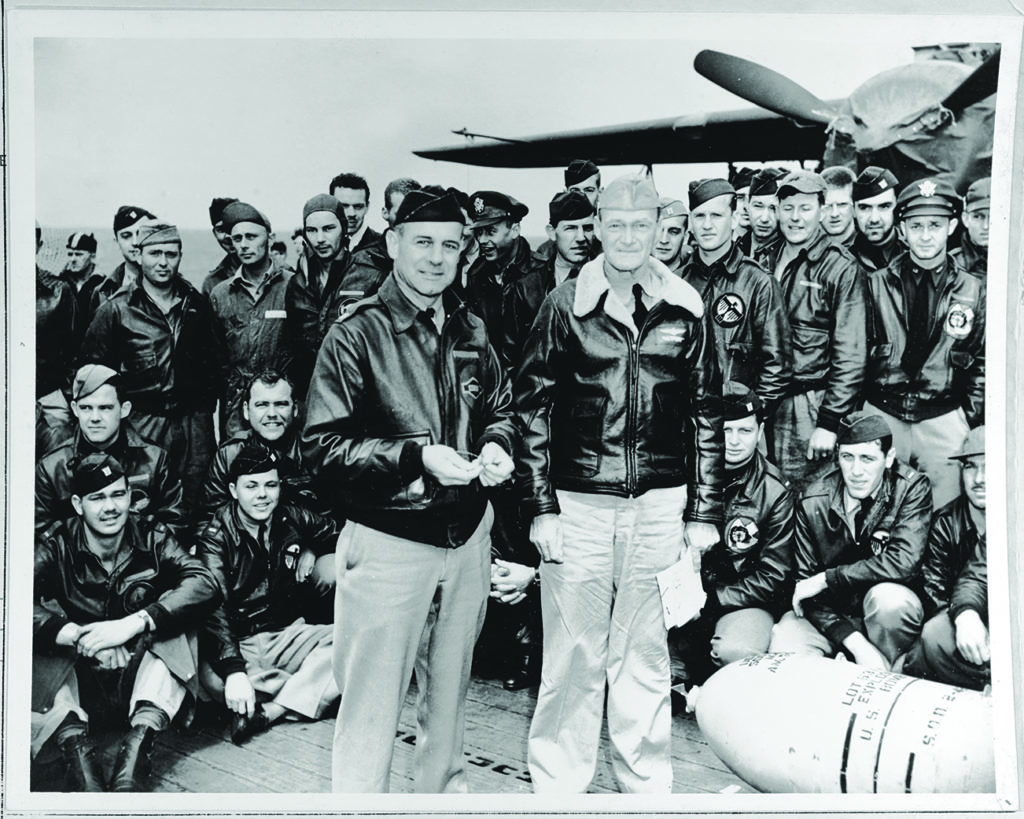
April 18, 1942—What a day! I’ll bet [“Tokyo” discernible in scribbles] is wondering what in the hell. General Quarters 0420. Condition 1 0730. Launched [“bombers” discernible in scribbles] 0820. The last one was off at 0920. Weather bad and sea worse than rough. A beautiful job of flying. Hardly possible to think those [scribbled out] would make it. At 0830 sank patrol vessel. 2 more patrol vessels went down about 3:30 p.m. Nashville picked up survivors. [scribbled out] had bad day. One plane crashed into the sea—all rescued. 3 damaged on landing. Secured from Condition I 6:30 p.m., into Condition II. [“Tokyo” discernible in scribbles] admitted bombing. No report from our side, but I know it was successful. This is history. To Bed.
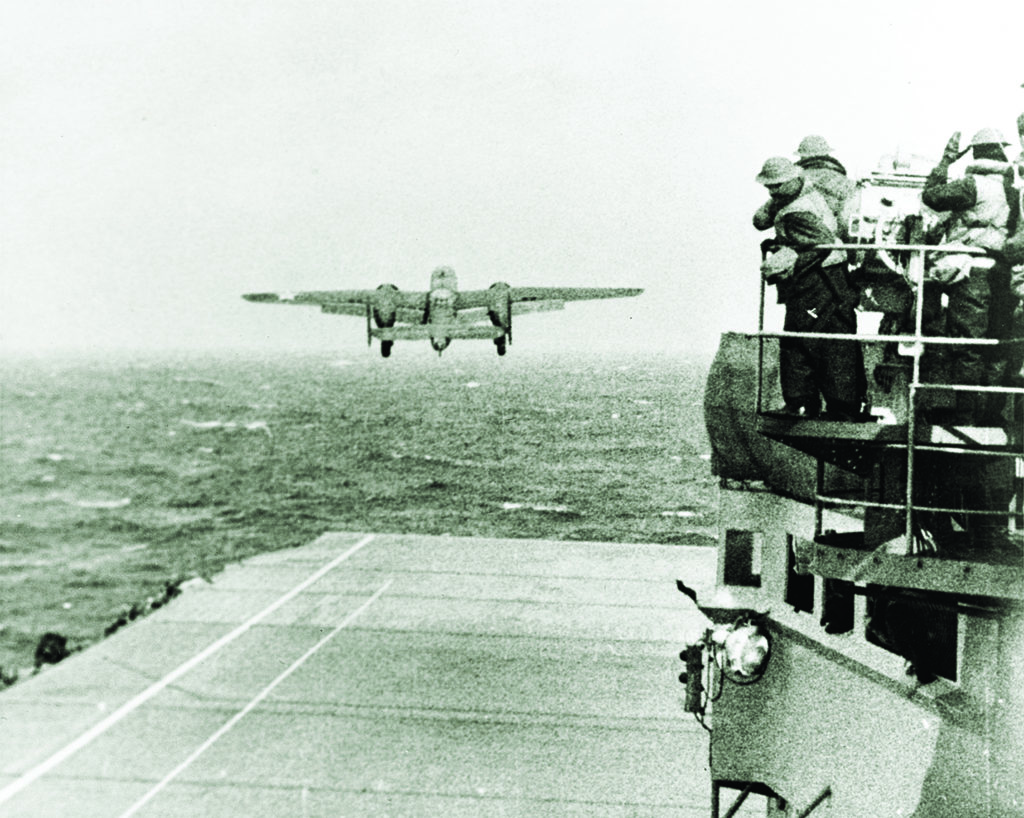
April 19, 1942—Joined destroyers. [“Tokyo” discernible in scribbles] denies everything. Funny, we haven’t even announced we bombed.
Monday, April 20, 1942—General Quarters 0500. 2400–0400 watch. Gun drills. Quarters and & abandon ship drill. 1600-1800 watch. Jap battlewagon rumored at Wake. Take a sock at them, maybe. Course looks homeward bound.
Tuesday, April 21, 1942—Weather still cold & wet.
Thursday, April 23, 1942—Warmed up, but still need the sheepskin.
Friday, April 24, 1942—A very commonplace journey home. Torpedo planes from our carriers staged an attack on us. Hope we never really run into such an attack. They are certain disaster! Our float planes flew as the ocean is fairly smooth. After 3 weeks of rough sea, a pleasant change. Wrote letters.
On April 27, 1942, Captain Ellis Zacharias of USS Salt Lake City swore in Robert D. Taplett, USMC, as a 1st lieutenant.
April 30, 1942—Under way again. Left laundry ashore.
Thursday, May 7, 1942—Mark up another trip across the equator—my third. Hot as blazes. Sub alerts. Destroyer dropped one charge. Big battle in Solomons. Heading for no one knows. Probably the Solomons. Sleeping is terrible. Getting closer to trouble.
Saturday, May 9, 1942—Carrier planes doing lots of dive-bombing and strafing practice & high-altitude. What a change from 20 days ago, when we were off Tokyo, practically freezing.
Sunday, May 10, 1942—Mother’s Day, near Fiji. Warm and bright. Things look better in the Southwest Pacific, right where we are headed! Alert: an unidentified plane, proved to be a R.A.A.F. B-24. Chicago Times correspondent, [Keith] Wheeler, is from Huron. Knows George DeKlotz.
Monday, May 11, 1942—Still in the same area,
N 7 E of New Caledonia. Fueled.
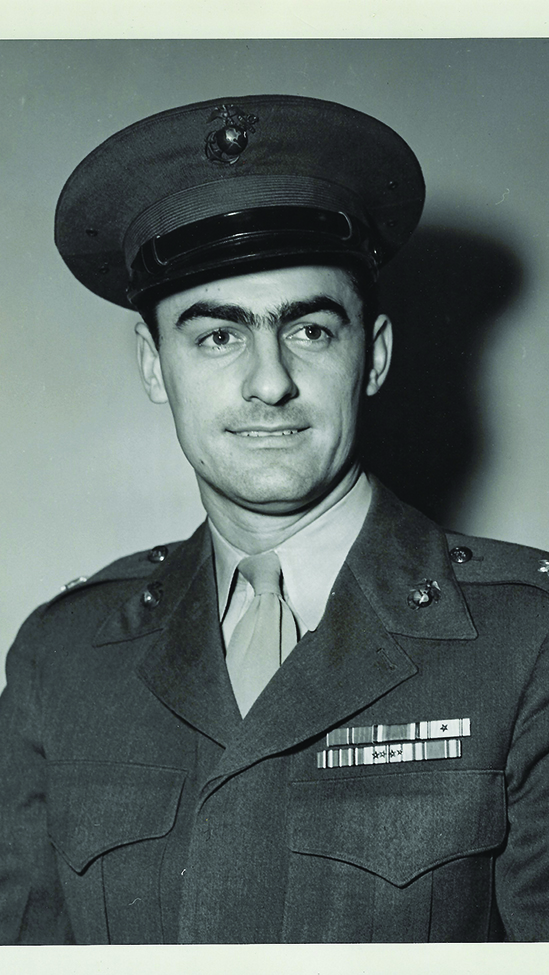
Salt Lake City fought in March 1943 in a decisive action near the Aleutians chain. Naval historian Samuel Eliot Morison called the Battle of the Komandorski Islands “the last heavy gunfire daylight action, with no interference by air power, submarines or torpedoes.” Afterwards, Taplett was transferred to the Command & General Staff School at Fort Leavenworth, where he served from January to March 1944. He fought at Guam, where John Ptak, his best friend, was killed. In 1946, Robert Taplett married Patricia Kingston in Woodside, California. His assignments 1946-50 included commanding navy supply barracks at Clearview, Utah, at Treasure Island in San Francisco Bay, and at Alameda Naval Air Station in Alameda, California, as well as service with the 1st Marine Division headquarters battalion at Camp Pendleton, California.
He mobilized with the First Provisional Marine Division in 1950 as part of the “Fire Brigade” that blunted the North Korean attack on the Pusan perimeter. He led the amphibious landing at Inchon and participated in the capture of Seoul, securing the Government Building for the retransfer of power to President Syngman Rhee. After the Battle of the Chosin Reservoir, he received, besides the Navy Cross, two Silver Stars, the Legion of Merit, and a Bronze Star. In the 1950s, Colonel Taplett lectured on close air support, was academic director of the Basic School at Quantico, Virginia, and served at Marine Corps headquarters in Washington, DC, and in Hawaii. Upon retiring from the Marine Corps in 1960, he worked for professional associations and the U.S. Postal Service. He and his wife, wed 58 years, had six children and nine grandchildren. In 2003 he recounted his experiences at Chosin in a memoir, Dark Horse Six, a title derived from his battalion’s radio call, “Dark Horse.” Later that year, Robert D. Taplett died. He was 86. With Patricia, who died in 2007, he lies at Arlington National Cemetery.
_____
This story appeared in the August 2020 issue of American History.

